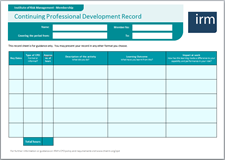Continuing professional development
It is critical to the maintenance of professionalism and professional standing that individuals keep abreast of the latest tools, techniques and thinking in their chosen field of speciality. Likewise, it is vital that the IRM can be confident that those that we qualify and continue to certify as professional risk managers are indeed operating with the latest knowledge at their fingertips. In this way, both individual members and the professional body as a whole can grow and maintain the expertise, and the reputation, of the risk management profession.
Qualified members of IRM - that is, anyone entitled to use the post-nominals IRMCert, GradIRM, SIRM, MIRM/CMIRM or FIRM/CFIRM – are therefore required to complete a minimum of 30 hours of continuing professional development (CPD) annually in order to maintain their professional designation.
CPD activity should be personal to your needs and the role you hold, but should also be underpinned by the Professional Standards in Risk Management. These reflect the IRM’s expectations of the knowledge, skills and behaviours that are required from those working in risk management at any level.
Almost anything which improves your knowledge and skills can be considered CPD, including “on the job” learning. The IRM recognises two distinct types of CPD – formal and informal.
Formal CPD
Formal CPD is generally structured and consists of interactive and participation-based activities such as attending training courses, workshops, webinars, special interest groups, regional group events, undertaking e-learning courses, making presentations, writing articles or presenting at conferences.
Informal CPD
Informal or self-assessed CPD is less structured. Activities could include, for example, reading relevant publications and news articles, or listening to podcasts.
You should try to maintain a balance between formal and informal activities.
For more information download the CPD Guide »
The IRM has a responsibility to ensure that members are engaging in satisfactory levels of CPD and we therefore audit annually the CPD activity of a random sample of members.








